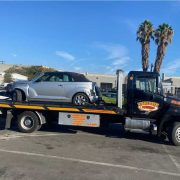[og_img]
Yup, I’ve already been in the latest cop car. As the old joke goes, I was in the front seat—not the back. In fact, I am one of the first civilians to drive the 2020 Ford Police Interceptor Utility Hybrid, which is a 2020 Ford Explorer modified for police use. It’s also the first hybrid engineered to be pursuit rated, meaning it’s up to hardcore police work when it goes on sale later this summer.
Getting to this point has been an interesting evolution for Ford, which was synonymous with cop car for years when the sight of Crown Victoria made you instantly check your speedometer and hope you weren’t over the limit enough to be worth pulling over. Ford stopped taking orders for the Crown Vic–based patrol car in April 2011 after 19 years and offered men in blue their choice of an Interceptor based on the Ford Taurus sedan or Explorer SUV.
The other evolution is Ford’s hybrid system, which becomes a first for police duty. The Interceptor Utility uses the automaker’s fourth-generation hybrid system. The first one dates back to the 2005 Ford Escape, a favorite among New York cabbies who anticipate its return with the new 2020 Escape.







A Police Interceptor Hybrid contributes to the scale Ford seeks for its fourth-generation modular hybrid system, which was designed to fit into vehicles of assorted sizes, from the compact Escape to the F-150 hybrid due next year, with 90 percent of the parts shared despite the size of the vehicle. The system can go in even larger vehicles, but Ford is not talking about potential future use for heavy-duty pickups or the seemingly logical application across the commercial vehicle lineup.
For the 2020 Police Interceptor Utility, the standard drivetrain is the 3.3-liter V-6 hybrid with a combined 318 hp and 322 lb-ft of torque. Optional powertrains are the 285-hp, 260-lb-ft naturally aspirated 3.3-liter or the 400-hp, 415-lb-ft 3.0-liter turbocharged EcoBoost V-6. All are mated to a 10-speed automatic, and all-wheel drive is standard.
Ford had some standard hybrids at its test track in Dearborn for us to take a quick spin. Explorers are modified to become Interceptors, including upgrading the engine so when the controller senses pursuit driving, it engages special tuning optimized for quicker throttle response, transmission logic, and reduced concern for fuel consumption. A short course was set up to give us a chance to accelerate hard, slam on the brakes, and corner around some cones. The time behind the wheel was only a few minutes, but it was enough to discern a few things.
Tossing the SUV into gear is via a traditional column shifter for police duty—the civilian Explorer has a rotary dial, which you don’t want to be fiddling with when every second counts.
The larger brakes on the police vehicle have serious bite. Coming to a hard stop was effortless. Trying to brake gently was not: They grabbed hard with the slightest touch. Ford vehicle dynamics engineer Shin Scott said he has spent a lot of time in the Explorer and the Interceptor and appreciates the ability to brake late in the police vehicle and still negotiate turns. “You get really used to them, and then you find that you really enjoy them. You know that they are there, especially at the really high-speed braking points.”


The Interceptor’s immediate torque, providing an initial jump in response, brings it to high speeds quickly and requires more from the brakes, Scott said. “To be able to get the brakes right when you want them is really important.” We also noticed how quickly the vehicle decelerates when you lift your foot off the gas. The engineer said the police hybrid is tuned for track work, and the regen is programmed to produce power at different times than the regular Explorer. Cooling upgrades include special ducts to cool the brakes.
Michigan State Police testing recorded a top speed of 137 mph for the hybrid and 149 mph for the EcoBoost, with 0–60 mph taking just 7.8 seconds for the hybrid, 7.3 for the 3.3, and 5.8 for the 3.0-liter EcoBoost. Overall performance was deemed superior to even the V-8 competition from Dodge and Chevy.
Wanting more time in the cruiser, I joined Scott for a hot lap, compete with a bit of drifting but no curb jumping even though the Interceptor has uniquely sized 265/60R18 108V Goodyear Eagle Enforcers on steel wheels that are capable of surviving an 8-inch curb jump as well as providing better performance. Ground clearance of the hybrid is 7.4 inches, which is 2.0 inches lower than the non-hybrid version and 2.0 inches higher than the SUV with the 3.0-liter EcoBoost.
At top speeds, Scott said he has more body control in the police vehicle, which provides the confidence to drive faster.








On the longer handling course with the engineer, my butt cheeks got a better read on the stiffer suspension: The shocks and springs are tuned to handle pursuits, so the vehicle does not ride as comfortably, but when it goes airborne at high speeds, even on off-camber jumps, the vehicle lands with authority and aplomb.
Most of the time a police vehicle is not going anywhere. The hybrid is billed as ideal for a job where 60 percent of the time the car is idling. Onboard electrical equipment is powered by the lithium-ion battery so the engine can be shut off much of the time and officers can continue to work, running the vehicle intermittently to charge the battery. The hybrid drivetrain will save between $3,500 and $5,700 per vehicle per year, Ford calculates. There can be a $3,509 savings from using 1,200 fewer gallons of gas at $2.75 a gallon in a hybrid getting 24 mgp in combined city/highway driving. The Interceptor Utility hybrid starts about $41,000; deleting the hybrid option saves about $3,500, and upgrading to the 3.0-liter EcoBoost adds about $700 to the sticker price.
A Ford-exclusive feature is 180 pounds worth of structural reinforcement to withstand a 75-mph rear impact—an all too common occurrence for police vehicles stopped on the side of the road or at an accident scene. The regular Explorer only needs to meet the 50-mph federal standard.
The police vehicles go on sale this summer. Of the roughly 8,000 orders in the system already, about 1,100 are for the hybrid. Ford executives expect that number to increase with awareness. Ford is the largest supplier of police vehicles, with about two-thirds of the market, and sells close to 30,000 a year.
The post 2020 Ford Police Interceptor Hybrid Review: 2020 Explorer with a Badass Badge appeared first on Motortrend.
[ad_2]
Source link








Comments